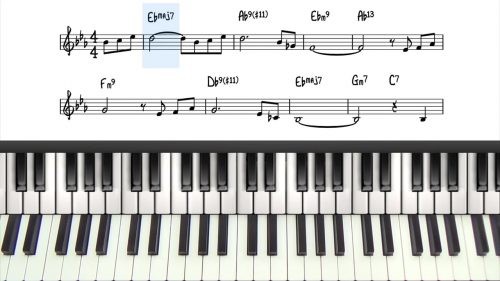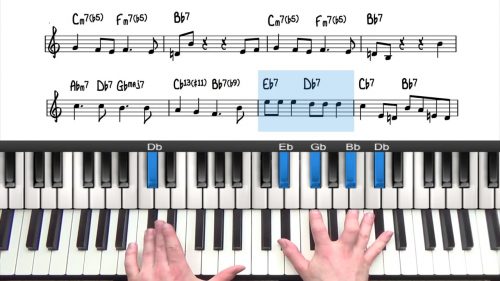How To Practice Time
In this 5 minute masterclass we’re going talk about time, and how to improve you own time feel and detect your bad tendencies.
One of my main teachers, a great pianist and educator Olaf Polziehn taught me about the importance of time, and gave me numerous tips how to practice it. In this lesson I’m going to share some of these ideas.
Your Best Friend When Practicing… The Metronome
I like to use metronome almost 100 percent of the time when practicing. There are infinite amount of ways you can use it, from all different tempos to all divisions of the beat as well as complex metric modulations.
One of the most important exercises I learned from my teacher was simple etude from Charles-Louis Hanon, which I’m playing still almost every day. You can buy the Hanon book online or in any music store.
We will explore this exercise using the metronome as a guide.
Chordal Exercises Using 251s and 2516 Progressions
We will take a 4 bar long 25 progression in C. Let’s take a slow tempo and first play with simple voicings such as drop 2. First we will play half notes, then we can think triplets with the metronome, and practice placing the voicings on different triplets.
Next we will keep the same 2516, and play a whole note on left hand, whilst improvising in the right hand. We’re going to do this with the same slow tempo, but you can and should practice all these exercises in all different tempos.
Now, we can divide the quarter note into different divisions, from straight 8th notes to triplets, 16 notes, 16 note triplets and so on.
Listen To Your Time!!
Always whilst doing these exercises, remember to really listen your time, are you behind or front of the beat? and detect your bad tendencies, and work on those.
This is a nice way to practice different things simultaneously, and you can add more levels into this exercise; first of course in different keys, then for example with a walking bass line, and so on, the options and variations are limitless.
Lesson Downloads
-
How To Practice Time – Lesson Notation File Type: pdf
Practice Tips
-
Practice these exercises in different tempos, maybe a good range is 60 to 120.
-
Also play the exercises in different keys to improve your dexterity around the keyboard.
-
Try to land directly on the metronome beat. Pay attention to where you are landing. You must be critical and observant whilst doing these exercises.
- Also try to ensure that all of the notes are the same volume and sound.








This is a fantastic lesson Tuomo, thank you ! Could you tell me a bit more about the notes that you played in your left hand in the Walking Bass section ? Thanks.
Hi Natasha, thanks for writing!
When practicing with a bass line like this, I would recommend to memorize and use the exact same bass line repeatedly, so you will fast get to the point where you don’t have to pay attention to the left hand, and can focus on the right hand 100 %
Check out attached picture for an example bass line over D-7 G7 Cmaj7 A7 that you can use. This one works on every other key as well, with maybe switching octaves if needed :)
In general, when creating bass lines, you should get the root on the beat 1, then either by using chromatic approach notes or chord tones, move to the next beat no. 1 and the root of the new chord.
If you’re interested in walking bass lines, go check out the 5-minute masterclasses on the subject:
pianogroove.com/jazz-piano-lessons/walking-basslines-revealed/
pianogroove.com/jazz-piano-lessons/walking-bass-line-rhythm-changes/
pianogroove.com/jazz-piano-lessons/walking-bass-line-take-the-a-train/
pianogroove.com/jazz-piano-lessons/walking-bass-line-softly-as-in-a-morning-sunrise/
Hi Tuomo. Hope you are well.
Just a question about time signatures in Hanon. Initially when I started studying the exercises, I just looked at it as if it were 8th notes. So putting the metronome from 60 to 120 seems understandable.
But they are all 16th notes, so even if I start at 60, its already exceedingly difficult.
Can you confirm your intent is to practice at 60 as if the 16th were 8th notes in common time?
Thanks.
Chris
Hi Kris, thanks for writing!
The exercise can be modified to fit your needs easily. If you start with tempo 60 and treat the notes as 8th notes, and gradually work until 120 (still with the 8th notes), then you can put the metronome back to 60 and start with the 16th notes (8th notes in tempo 120 equals 16th notes in tempo 60).
Here an example practice tempos you can try (of course as you have practiced this already, you can start from wherever you feel):
Tempo 1: 60 (8th notes) or 30 (16th notes)
Tempo 2: 90 (8th notes) or 45 (16th notes)
Tempo 3: 120 (8th notes) or 60 (16th notes)
Tempo 4: 150 (8th notes) or 75 (16th notes)
Once you have mastered the wanted exercises on these tempos, you can do them in another key, still keeping the same fingering.
Hope this helps, let me know if you have any further questions!
-Tuomo
Around 4:45 there’s reference to playing “the last triplet”. I don’t fully understand what you are doing, although I can hear it. What I think I’m hearing and what you are saying is attached.
Is this correct?
Hi Chris,
yes you’re right, the ‘”last” triplet means the last of the 8’ note triplets, here all triplets to practice with (attachment):
When you’re practicing with a chord the way I’m shoving on the video, sing the triplets in your mind while playing, that will help to play the chord in better time. Start slowly; find the tempo you feel comfortable in, and work up from there.
Thanks, let me know if I can help with anything else,
-Tuomo